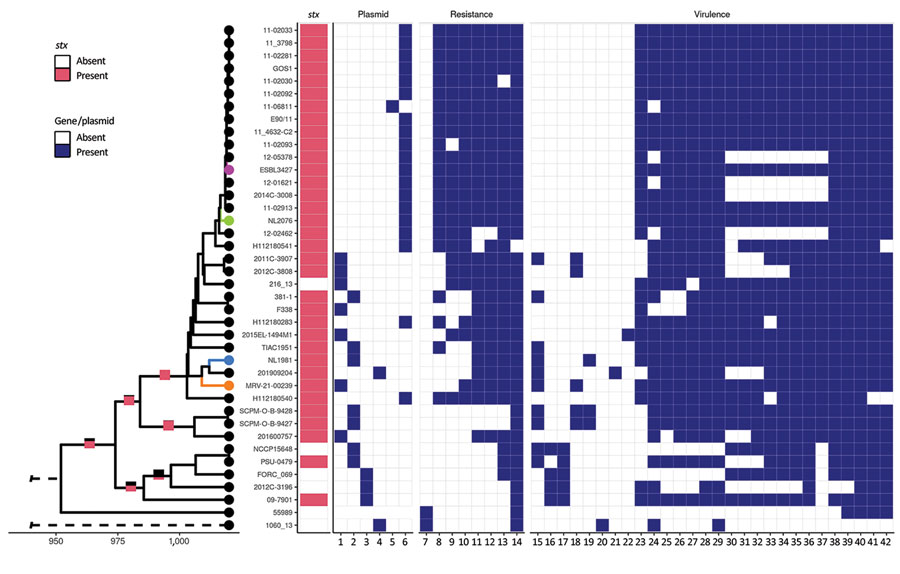Volume 28, Number 9—September 2022
Dispatch
Sporadic Occurrence of Enteroaggregative Shiga Toxin–Producing Escherichia coli O104:H4 Similar to 2011 Outbreak Strain
Figure 1

Figure 1. Single-linkage hierarchical clustering tree of enteroaggregative Shiga toxin–producing Escherichia coli O104:H4 from the Netherlands and reference sequences. Tree results from core- and accessory-genome multilocus sequence typing with a heatmap indicating presence or absence of stx-encoding bacteriophage, plasmids, resistance, and virulence genes. Only genes present in at least 1 isolate are depicted. Colored isolates are those added during this study: green indicates the patient isolate from the Netherlands in 2020, purple the pork isolate from the Netherlands in 2017, blue the patient isolate from the Netherlands in 2019, orange the patient isolate from Austria in 2021. The stacked bar plots on a few selected branches in the tree indicate the likelihood at the downstream nodes of having contained an stx-encoding phage (black: absence, pink: presence). Lane 1, IncFII(prSB107); lane 2, IncB/O/K/Z; lane 3, IncFIB(AP001918); lane 4, IncFII; lane 5, Col(BS512); lane 6, Incl1-l(Alpha); lane 7, tet(B); lane 8, blaCTM-M-15; 9, tet(A); lane 10, aph(3′′)-lb, aph(6)-id, sul2; lane 11, dfrA7; lane 12, qacE, sul1; lane 13, blaTEM-1B; lane 14, formA, mdf(A); lane 15, traT; lane 16, agg3A, agg3D; lane 17, agg3B, agg3C, astA; lane 18, iss; lane 19, celb; lane 20, aadA1, aadA2b, ant(3′′)-la blaOXA-1, catA1, eatA; lane 21, ireA; lane 22, hra; lane 23, neuC; lane 24, gad; lane 25, mchB; lane 26, mchC; lane 27, stx2A, stx2B; lane 28, aaiC, capU, iucC, lpfA; lane 29, terC; lane 30, aatA; lane 31, ORF3; lane 32, ORF4; lane 33, aap; lane 34, aggR; lane 35, aar; lane 36, afaD; lane 37, aggA, aggB, aggC, aggD, sepA; lane 38, mchF; lane 39, iha; lane 40, iutA, pic, sigA; lane 41, fyuA; lane 42, irp2. ESBL, extended spectrum β-lactamase; ORF, open reading frame.